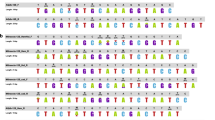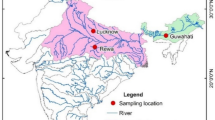Abstract
Charophytes are macrophytic green algae, occurring in standing and running waters throughout the world. Species descriptions of charophytes are contradictive and different determination keys use various morphologic characters for species discrimination. Chara intermedia Braun, C. baltica Bruzelius and C. hispida Hartman are treated as three species by most existing determination keys, though their morphologic differentiation is based on different characteristics. Amplified fragment length polymorphism (AFLP) was used to detect genetically homogenous groups within the C. intermedia-C. baltica-C. hispida-cluster, by the analysis of 122 C. intermedia, C. baltica and C. hispida individuals from central and northern Europe. C. hispida clustered in a distinct genetic group in the AFLP analysis and could be determined morphologically by its aulacanthous cortification. However, for C. intermedia and C. baltica no single morphologic character was found that differentiated the two genetic groups, thus C. intermedia and C. baltica are considered as cryptic species. All C. intermedia specimen examined came from freshwater habitats, whereas the second group, C. baltica, grew in brackish water. We conclude that the species differentiation between C. intermedia and C. baltica, which is assumed to be reflected by the genetic discrimination groups, corresponds more with ecological (salinity preference) than morphologic characteristics.
Based on the genetic analysis three differing colonization models of the Baltic Sea and the Swedish lakes with C. baltica and C. intermedia were discussed. As samples of C. intermedia and C. baltica have approximately the same Jaccard coefficient for genetic similarity, we suggest that C. baltica colonized the Baltic Sea after the last glacial maximum from refugia along the Atlantic and North Sea coasts. Based on the similarity of C. intermedia intermediate individuals of Central Europe and Sweden we assume a colonization of the Swedish lakes from central Europe.

Similar content being viewed by others
References
Adams, R. P., J. A. Morris, R. N. Pandey & A. E. Schwarzbach, 2005. Cryptic speciation between Juniperus deltoides and Juniperus oxycedrus (Cupressaceae) in the Mediterranean. Biochemical Systematics and Ecology 33: 771–787.
Anadon, P., R. Utrilla & A. Vazquez, 2002. Mineralogy and Sr–Mg geochemistry of charophyte carbonates: a new tool for paleolimnological research. Earth and Planetary Science Letters 197: 205–214.
Benzie, J. A. H., E. Ballment, J. R. M. Chisholm & J. M. Jaubert, 2000. Genetic variation in the green alga Caulerpa taxifolia. Aquatic Botany 66: 131–139.
Bisson, M. A. & D. Bartholomew, 1984. Osmoregulation or turgor regulation in Chara? Plant Physiology 74: 252–255.
Bhattacharya, D. & L. Medlin, 1998. Algal phylogeny and the origin of land plants 1. Plant Physiology 116: 9–15.
Björck, S., 1995. A review of the history of the Baltic Sea, 13.0–8.0 ka BP. Quaternary International 27: 19–90.
Blindow, I., 2000. Distribution of Charophytes along the Swedish coast in relation to salinity and eutrophication. International Review of Hydrobiology 85: 707–717.
Blindow, I. & M. Schütte, 2006. Elongation and mat formation of Chara aspera under different light and salinity conditions. Hydrobiologia (in revision).
Charalambidou, I. & L. Santamaria, 2005. Field evidence for the potential of waterbirds as dispersers of aquatic organisms. Wetlands 25: 252–258.
Corillion, R., 1972. Les Charophycees de France et d’ Europe Occidentale. Otto Koeltz Verlag, Koenigstein-Taunus.
Excoffier, L., P. E. Smouse & J. M. Quattro, 1992. Analysis of molecular variance inferred from metric distances among DNA haplotypes: application to human mitochondrial DNA restriction data. Genetics 131: 479–491.
Fox, A. D., T. A. Jones, R. Singleton & A. D. Q. Agnew, 1994. Food supply and the effects of recreational disturbance on the abundance and distribution of wintering Pochard on a gravel pit complex in southern Britain. Hydrobiologia 280: 253–261.
Garcia-Mas, J., M. Oliver & H. Gomez-Paniagua, 2000. Comparing AFLP, RAPD and RFLP markers for measuring genetic diversity in melon. Theoretical and Applied Genetics 101: 860–864.
Gleeson, D. M., R. L. J. Howitt & N. Ling, 1999. Cryptic species of mudfish in New Zealand. Molecular Ecology 8: 47–57.
Gollerbakh, M. M. & L. K. Krasavina, 1983. Translated by Z. Sinkeviciene. Opredelitel´ presnovodnykh vodoroslej SSSR, Vypusk 14, Kharovyje codorosili-Charophyta. Leningrad “Nauka”.
Hampe, A., J. Arroyo, P. Jordano & R. J. Petit, 2003. Rangewide phylogeography of a bird-dispersed Eurasian shrub: contrasting Mediterranean and temperate glacial refugia. Molecular Ecology 12: 3415–3426.
Hongtrakul, V., G. M. Huestis & S. J. Knapp, 1997. Amplified fragment length polymorphisms as a tool for DNA fingerprinting sunflower germplasm: genetic diversity among oilseed inbred lines. Theoretical and Applied Genetics 95: 400–407.
Kardolus, J. P., H. J. Van Eck & S. J. Van den Berg, 1998. The potential of AFLPs in biosystematics: a first application in Solanum taxonomy (Solanaceae). Plant Systematic and Evolution 210: 87–103.
Karol, K. G., R. M. McCourt, M. T. Cimino & C. F. Delwiche, 2001. The closest living relatives of land plants. Science 294: 2351–2353.
Knapton, R. W. & S. A. Petrie, 1999. Changes in distribution and abundance of submerged macrophytes in the Inner Bay at Long Point, Lake Erie: implications for foraging waterfowl. Journal of Great Lakes Research 25: 783–798.
Kontula, T. & R. Väinölä, 2001 Postglacial colonization of Northern Europe by distinct phylogeographic lineages of the bullhead, Cottus gobio. Molecular Ecology 10: 1983–2002.
Krause, W., 1997. Charales (Charophyceae). In Ettl, A., G. Gärtner, H. Heynig & D. Mollenhauer (eds), Süßwasserflora von Mitteleuropa. Vol. 18, G. Fischer, Jena.
Kremling, K., J. J. S. Tokos, L. Brugmann & H. P. Hansen, 1997. Variability of dissolved and particulate trace metals in the Kiel and Mecklenburg Bights of the Baltic Sea 1990–1992. Marine Pollution Bulletin 34: 112–122.
Leskinen, E., C. Alström-Rapaport & P. Pamilo, 2004. Phylogeographical structure, distribution and genetic variation of the green algae Ulva intestinalis and U. compressa (Chlorophyta) in the Baltic Sea area. Molecular Ecology 13: 2257– 2265.
Link, W., C. Dixkens, M. Singh, M. Schwall & A. E. Melchinger, 1995. Genetic diversity in European and Mediterranean faba bean germ plasm revealed by RAPD markers. Theoretical and Applied Genetics 90: 27–32.
Mannschreck, B., 2003. Genetische und morphologische Differenzierung ausgewählter Arten der Gattung Chara. Doktorarbeit TU-München. Shaker Verlag, Aachen.
Mannschreck, B., T. Fink & A. Melzer, 2002. Biosystematics of selected Chara species (Charophyta) using amplified fragment length polymorphism. Phycologia 41: 657–666.
Marin, B. & M. Melkonian, 1999. Mesostigmatophyceae, a new class of streptophyte green algae revealed by SSU rRNA sequence comparisons. Protist 150: 399–417.
McClintock, K. A. & M. J. Waterway, 1994. Genetic differentiation between Carex lasiocarpa and C. pellita (Cyperaceae) in North America. American Journal of Botany 81: 224–231.
McCourt, R. M., C. F. Delwiche & K. G. Karol, 2004. Charophyte algae and land plant origins. Trends in Ecology & Evolution 19: 661–666.
Nesbo, C. L., T. Fossheim, L. A. Vollestad & K. S. Jakobsen, 1999. Genetic divergence and phylogeographic relationships among European perch (Perca fluviatilis) populations reflect glacial refugia and postglacial colonization. Molecular Ecology 8: 1387–1404.
Odat, N., G. Jetschke & F. H. Hellwig, 2004. Genetic diversity of Ranunculus acris L. (Ranunculaceae) populations in relation to species diversity and habitat type in grassland communities. Molecular Ecology 13: 1251–1257.
Pankow, H., 1990. Ostsee-Algenflora. Gustav Fischer Verlag, Jena.
Perkins, S. L., 2000. Species concepts and malaria parasites: detecting a cryptic species of Plasmodium. Proceedings of the Royal Society London B 267: 2345–2350.
Peterson, S. W., 2000. Bio-network news. Diversity 15: 31.
Pierce, S. K., L. M. Rowlandfaux & S. M. Obrien, 1992. Different salinity tolerance mechanisms in Atlantic and Chesapeake Bay conspecific oysters – glycine betaine and amino acid pool variations. Marine Biology 113: 107–115.
Ray, S., M. Klenell, K. S. Choo, M. Pedersen & P. Snoeijs, 2003. Carbon acquisition mechanisms in Chara tomentosa. Aquatic Botany 76: 141–154.
Roldan-Ruiz, I., J. Denauw, E. Van Bockstaele, A. Depicker & M. De Loose, 2000. AFLP markers reveal high polymorphic rates in ryegrasses (Lolium spp.). Molecular Breeding 6: 125–134.
Roy, B. A., D. R. Vogler, T. D. Bruns & T. M. Szaro, 1998. Cryptic species in the Puccinia monoica complex. Mycologia 90: 847–854.
Says-Lesage, V., P. Roeckel- Drevet, A. Viguie, J. Tourvieille, P. Nicolas & D. T. Labrouhe, 2002. Molecular variability within Diaporthe/Phomopsis helianthi from France. Phytopathology 92: 308–313.
Schneider, S., D. Roessli & L. Excoffier, 2000. Arlequin: a software for population genetics data analysis. Version 2000. Genetics and Biometry Lab, Dept. of Anthropology, University of Geneva.
Schneider, S., C. Ziegler & A. Melzer, 2006. Growth towards light as adaptation to high light conditions in Chara branches. New Phytologist 172: 83–91.
Schubert, H. & I. Blindow, 2003. Charophytes of the Baltic Sea. Gantner Verlag, Rugell.
Schwarz, G., M. Herz, X. Q. Huang, G. Wenzel, W. Michalek, A. Jahoor & V. Mohler, 2000. Application of fluorescence-based semi-automated AFLP analysis in barley and wheat. Theoretical and Applied Genetics 100: 545–551.
Shaw, A. J., 2001. Biogeographic patterns and cryptic speciation in bryophytes. Journal of Biogeography 28: 253–261.
Shepherd, V. A., M. J. Beilby & T. Shimmen, 2002. Mechanosensory ion channels in charophyte cells: the response to touch and salinity stress. European Biophysics Journal 31: 341–355.
Taberlet, P., L. Fumagalli, A.-G. Wust-Saucy & J.-F. Cosson, 1998. Comparative phylogeography and postglacial colonization routes in Europe. Molecular Ecology 7: 453–464.
Van de Peer, Y. & R. De Wachter, 1994. TREECON for Windows: a software package for the construction and drawing of evolutionary trees for the Microsoft Windows environment. Computer Applications in the Biosciences 10: 569–570.
Vos, P., R. Hogers, M. Bleeker, M. Reijans, T. Van de Lee, M. Hornes, A. Frijters, J. Pot, J. Peleman, M. Kuiper & M. Zabeau, 1995. AFLP: a new technique for DNA fingerprinting. Nucleic Acids Research 23: 4407–4414.
Winter, U. & G. O. Kirst, 1991. Partial turgor pressure regulation in Chara canescens and its implications for a generalized hypothesis of salinity response in Charophytes. Botanica Acta 104: 37–46.
Winter, U., I. Soulie-Marsche & G. O. Kirst, 1996. Effects of salinity on turgor pressure and fertility in Tolypella (Characeae). Plant Cell and Environment 19: 869–879.
Wood, R. D. & K. Imahori, 1965. Monograph of the Characeae. J. Cramer, Weinheim.
Yatabe, Y., S. Masuyama, D. Darnaedi & N. Murami, 2001. Molecular systematics of the Asplenium nidus complex from Mt. Halimum National Park, Indonesia: evidence of reproductive isolation among three sympatric rbcL sequence types. American Journal of Botany 88: 1517–1522.
Acknowledgements
We thank Markus Heinrichs and Irmgard Blindow for correcting the English and for helpful comments on the manuscript. Appreciation is extended to the many colleagues who helped in the charophyte collection. The project was financially supported by the German Research Foundation (DFG).
Author information
Authors and Affiliations
Corresponding author
Additional information
Handling editor: C. Sturmbauer
Rights and permissions
About this article
Cite this article
Boegle, M.G., Schneider, S., Mannschreck, B. et al. Differentiation of Chara intermedia and C. baltica compared to C. hispida based on morphology and amplified fragment length polymorphism. Hydrobiologia 586, 155–166 (2007). https://doi.org/10.1007/s10750-006-0571-8
Received:
Revised:
Accepted:
Published:
Issue Date:
DOI: https://doi.org/10.1007/s10750-006-0571-8




